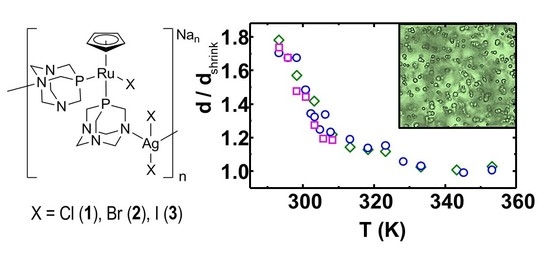Novel Ruthenium-Silver PTA-Based Polymers and Their Behavior in Water
Abstract
:1. Introduction
2. Materials and Methods
2.1. Materials
2.2. Methods
3. Results and Discussion
3.1. Synthesis of the Coordination Polymers
3.1.1. Synthesis of System-1): Na[RuCpCl(PTA)-μ-(PTA)-1κP:2κ2N-AgCl2]n
3.1.2. Synthesis of System-2 and System-3: Na[RuCpBr(PTA)- ![Polymers 11 01249 i001]() -(PTA)-1|P:2|2N-AgBr2]n (System-2), Na[RuCpI(PTA)-
-(PTA)-1|P:2|2N-AgBr2]n (System-2), Na[RuCpI(PTA)- ![Polymers 11 01249 i001]() -(PTA)-1|P:2|2N-AgI2]n (System-3)
-(PTA)-1|P:2|2N-AgI2]n (System-3)
3.2. Chemical Characterization
3.3. Optical Properties
3.4. Non-Ionic Character of the Polymer
3.5. Polymer Self-Assembling
3.6. Polymer De-Swelling
4. Conclusions
Author Contributions
Funding
Conflicts of Interest
References
- Lidrissi, C.; Romerosa, A.; Saoud, M.; Serrano-Ruiz, M.; Gonsalvi, L.; Peruzzini, M. Stable, water-soluble Pta-based Ru–Ag organometallic polymers. Angew. Chem. Int. Ed. 2005, 44, 2568–2572. [Google Scholar] [CrossRef] [PubMed]
- Frost, B.J.; Mebi, C.A.; Gingrich, P.W. Boron-nitrogen adducts of 1,3,5-triaza-7-phosphaadamantane (PTA): Synthesis, reactivity, and molecular structure. Eur. J. Inorg. Chem. 2006, 2006, 1182–1189. [Google Scholar] [CrossRef]
- Serrano Ruiz, M.; Romerosa, A.; Sierra-Martin, B.; Fernandez-Barbero, A. A water soluble diruthenium-gold organometallic microgel. Angew. Chem. Int. Ed. 2008, 47, 8665–8669. [Google Scholar] [CrossRef] [PubMed]
- Scalambra, F.; Serrano-Ruiz, M.; Romerosa, A. First water-soluble backbone Ru–Ru–Ni heterometallic organometallic polymer. Macromol. Rapid Commun. 2015, 36, 689–693. [Google Scholar] [CrossRef] [PubMed]
- Scalambra, F.; Serrano-Ruiz, M.; Gudat, D.; Romerosa, A. Amorphization of a Ru–Ru–Cd-Coordination Polymer at Low Pressure. ChemistrySelect 2016, 1, 901–905. [Google Scholar] [CrossRef]
- Scalambra, F.; Serrano-Ruiz, M.; Romerosa, A. Water driven formation of nano-channels: Unusual solid-state structural transformation of a heterometallic polymer. Dalton Trans. 2018, 47, 3588–3595. [Google Scholar] [CrossRef] [PubMed]
- Spokoyny, A.M.; Kim, D.; Sumrein, A.; Mirkin, C.A. Infinite coordination polymer nano- and microparticle structures. Chem. Soc. Rev. 2009, 38, 1218–1227. [Google Scholar] [CrossRef] [PubMed]
- Mohr, F.; Falvello, L.R.; Laguna, M. A silver(I) coordination polymer containing tridentate N- and P-coordinating 1,3,5-triaza-7-phosphaadamantane (PTA) ligands. Eur. J. Inorg. Chem. 2006, 2006, 3152–3154. [Google Scholar] [CrossRef]
- Frost, B.J.; Bautista, C.M.; Huang, R.; Shearer, J. Manganese complexes of 1,3,5-triaza-7-phosphaadamantane (PTA): The first nitrogen-bound transition-metal complex of PTA. Inorg. Chem. 2006, 45, 3481–3483. [Google Scholar] [CrossRef]
- Kirillov, A.M.; Filipowicz, M.; Guedes Da Silva, M.F.C.; Kłak, J.; Smoleński, P.; Pombeiro, A.J.L. Unprecedented mixed-valence Cu(I)/Cu(II) complex derived from N-methyl-1,3,5-triaza-7-phosphaadamantane: Synthesis, structural features, and magnetic properties. Organometallics 2012, 31, 7921–7925. [Google Scholar] [CrossRef]
- Scalambra, F.; Serrano-Ruiz, M.; Romerosa, A. Water and catalytic isomerization of linear allylic alcohols by [RuCp(H2O-κO)(PTA)2]+(PTA = 1,3,5-triaza-7-phosphaadamantane). Dalton Trans. 2017, 46, 5864–5871. [Google Scholar] [CrossRef]
- Romerosa, A.; Campos-Malpartida, T.; Lidrissi, C.; Saoud, M.; Serrano-Ruiz, M.; Peruzzini, M.; Garrido-Cárdenas, J.A.; García-Maroto, F. Synthesis, characterization, and DNA binding of new water-soluble cyclopentadienyl ruthenium(II) complexes incorporating phosphines. Inorg. Chem. 2006, 45, 1289–1298. [Google Scholar] [CrossRef]
- Akbayeva, D.N.; Gonsalvi, L.; Oberhauser, W.; Peruzzini, M.; Vizza, F.; Brüggeller, P.; Romerosa, A.; Sava, G.; Bergamo, A. Synthesis, catalytic properties and biological activity of new water soluble ruthenium cyclopentadienyl PTA complexes [(C5R5)RuCl(PTA)2] (R = H, Me; PTA = 1,3,5-triaza-7-phosphaadamantane). Chem. Commun. 2003, 264–265. [Google Scholar] [CrossRef]
- Serrano-Ruiz, M.; Lorenzo-Luis, P.; Romerosa, A. Easy synthesis and water solubility of ruthenium complexes containing PPh3, mTPPMS, PTA and mPTA, (mTPPMS = meta-triphenyphosphine monosulfonate, PTA = 1,3,5-triaza-7-phosphaadamantane, mPTA = N-methyl-1,3,5-triaza-7-phosphaadamantane). Inorg. Chim. Acta 2017, 455, 528–534. [Google Scholar] [CrossRef]
- Sierra-Martin, B.; Serrano-Ruiz, M.; García-Sakai, V.; Scalambra, F.; Romerosa, A.; Fernandez-Barbero, A. Self-organization and swelling of ruthenium-metal coordination polymers with PTA (metal = Ag, Au, Co). Polymers 2018, 10, 528. [Google Scholar] [CrossRef]
- Serrano-Ruiz, M.; Imberti, S.; Bernasconi, L.; Jadagayeva, N.; Scalambra, F.; Romerosa, A. Study of the interaction of water with the aqua-soluble dimeric complex [RuCp(PTA)2-μ-CN-1κC:2κ(2)N-RuCp(PTA)2](CF3SO3) (PTA = 1,3,5-triaza-7-phosphaadamantane) by neutron and X-ray diffraction in solution. Chem. Commun. 2014, 50, 11587–11590. [Google Scholar] [CrossRef]
- Gossens, C.; Dorcier, A.; Dyson, P.J.; Rothlisberger, U. pKa estimation of ruthenium(II)-arene PTA complexes and their hydrolysis products via a DFT/continuum electrostatics approach. Organometallics 2007, 26, 3969–3975. [Google Scholar] [CrossRef]
- Scalambra, F.; Holzmann, N.; Bernasconi, L.; Imberti, S.; Romerosa, A. Water Participation in Catalysis: An Atomistic Approach to Solvent Effects in the Catalytic Isomerization of Allylic Alcohols. ACS Catal. 2018, 8, 3812–3819. [Google Scholar] [CrossRef]
- Saeed, M.A.; Wong, B.M.; Fronczek, F.R.; Venkatraman, R.; Hossain, M.A. Formation of an amine-water cyclic pentamer: A new type of water cluster in a polyazacryptand. Cryst. Growth Des. 2010, 10, 1486–1488. [Google Scholar] [CrossRef]
- Denton, A.R.; Tang, Q. Counterion-induced swelling of ionic microgels. J. Chem. Phys. 2016, 145, 164901. [Google Scholar] [CrossRef] [Green Version]
- Capriles-González, D.; Sierra-Martín, B.; Fernández-Nieves, A.; Fernández-Barbero, A. Coupled deswelling of multiresponse microgels. J. Phys. Chem. B 2008, 112, 12195–12200. [Google Scholar] [CrossRef]






© 2019 by the authors. Licensee MDPI, Basel, Switzerland. This article is an open access article distributed under the terms and conditions of the Creative Commons Attribution (CC BY) license (http://creativecommons.org/licenses/by/4.0/).
Share and Cite
Sierra-Martin, B.; Serrano-Ruiz, M.; Scalambra, F.; Fernandez-Barbero, A.; Romerosa, A. Novel Ruthenium-Silver PTA-Based Polymers and Their Behavior in Water. Polymers 2019, 11, 1249. https://doi.org/10.3390/polym11081249
Sierra-Martin B, Serrano-Ruiz M, Scalambra F, Fernandez-Barbero A, Romerosa A. Novel Ruthenium-Silver PTA-Based Polymers and Their Behavior in Water. Polymers. 2019; 11(8):1249. https://doi.org/10.3390/polym11081249
Chicago/Turabian StyleSierra-Martin, Benjamin, Manuel Serrano-Ruiz, Franco Scalambra, Antonio Fernandez-Barbero, and Antonio Romerosa. 2019. "Novel Ruthenium-Silver PTA-Based Polymers and Their Behavior in Water" Polymers 11, no. 8: 1249. https://doi.org/10.3390/polym11081249
APA StyleSierra-Martin, B., Serrano-Ruiz, M., Scalambra, F., Fernandez-Barbero, A., & Romerosa, A. (2019). Novel Ruthenium-Silver PTA-Based Polymers and Their Behavior in Water. Polymers, 11(8), 1249. https://doi.org/10.3390/polym11081249







